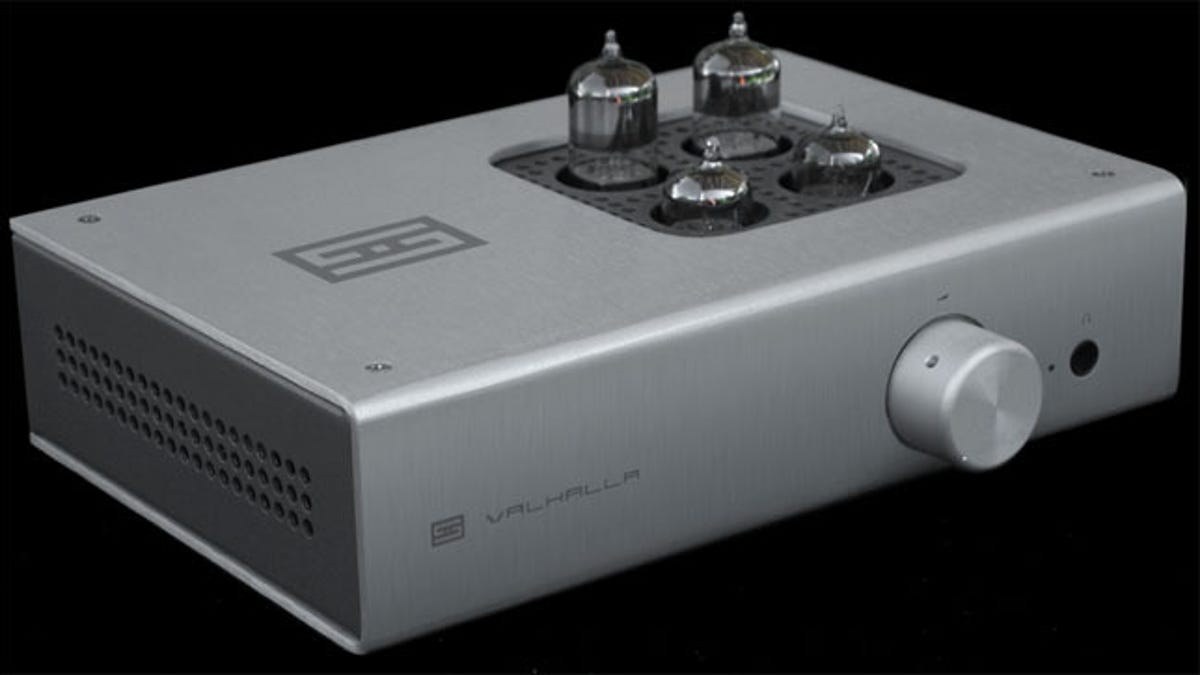A totally tubular headphone amplifier
If you want to hear how good your headphones can sound, try plugging them into Schiit Audio's Valhalla vacuum tube headphone amplifier.

Headphones can sound only as good as the amplifier they're plugged into. The difference in sound quality between the built-in headphone amp in a typical receiver or computer and a high-end amp can be surprisingly huge. True, the very best headphone amps can get expensive, but Schiit Audio's made-in-the-U.S. amps' prices start at $249.
I was blown away by the sound of Schiit's solid-state Asgard amp ($249) a few months ago, and now it's happening again with the new Schiit vacuum tube Valhalla amp ($349). Which one sounds better, the solid-state or the tube design? Read on.
The Valhalla's chassis is a near twin to the Asgard, except for the four tubes peeking out of the top panel. The brushed, all-metal chassis' fit and finish are excellent; the Valhalla looks like an expensive high-end component. The rear panel houses stereo RCA inputs, an on/off switch, and a power connector. The chassis measures 9 by 6.75 by 3.25 inches, and it weighs 7 pounds.
Technically speaking, the Valhalla is a Class A, single-ended triode headphone amplifier with no overall feedback. The amp's innards are stuffed with individual resistors, capacitors, etc,; just like a no-holds barred high-end design, and it delivers classic tube sound. The chassis, circuit board, and power transformer are all sourced from American suppliers, and the amp is hand-built in Newhall, CA; though the vacuum tubes are made in Russia. Like most high-end designs, the Valhalla is built to last a long time; it should have a useful working life of 10 or more years.
The tubes probably won't make it to the 10-year mark; they're rated for 3,000 to 5,000 hours of use, so if you listen to your headphones for 10 hours a week, you won't have to replace the tubes for at least 6 years. The tubes are guaranteed for 90 days, and Schiit sells replacement tube sets for $40.
I spent some time comparing the solid-state Schiit Asgard with the Valhalla, with my Grado RS-1 and Sennheiser HD-580 full-size headphones, and the brand-new Ultimate Ears UE Reference Monitor in-ear headphones.
The Valhalla warmed up the Grado's sound; the Asgard was leaner-sounding, but more transparent. The Valhalla's soundstage depth on the Walkmen's excellent new "Lisbon" CD was more spacious than the Asgard's, but don't get the wrong idea; the tubes didn't soften detail, and the band's guitars had plenty of bite. The Valhalla/Grado sound is fuller-bodied and organic; the Asgard/Grado combo offers greater clarity.
The Sennheiser HD 580's sound was more laid-back (with less treble) and more diffuse-sounding when directly compared with the Grado, so the differences between the Valhalla and Asgard were less dramatic, but still evident. Female vocals were especially natural-sounding over the HD-580. An above-average-sounding concert rock CD, like the Drive-By Truckers' "Live in Austin TX" had great dynamics, and its wide-open soundstaging made for a powerfully engaging listening experience. The Valhalla's sound may be somewhat less clear than the solid-state Asgard's, but the tubes' sweetening effect makes for a more enjoyable experience with less-than-stellar-sounding recordings, like Arcade Fire's compressed-to-the-point-it-hurts "The Suburbs" CD. The music still doesn't sound great, but the Valhalla made it less grating. The Valhalla made every CD sound a little sweeter and more beautiful than it really is.
Asgard or Valhalla, which is better? There's no clear winner here, though I'd go for the Valhalla, but if tube sound doesn't woo you, go ahead and save $100 and get the Asgard.
I just received a pair of Ultimate Ears' latest, the Reference Monitors in-ear headphones ($1,000). I like them a lot but for now I'll just say they sound better than any other in-ears I've played on a home headphone amp. The Schiit-UE combo had incredible resolution of fine detail but never sounded harsh. Watch for a full review of the UE Reference Monitor here soon. The Valhalla or Asgard, teamed up with Grado's excellent SR225i headphones ($200) are a great way to discover high-end sound on a budget.
The Valhalla is sold direct from Schiit Audio, with a 15-day satisfaction guarantee, so you can try the amp at home. I can't think of another American-made audio component that sells for the prices Schiit charges for its two current designs; or budget-priced components that come backed up with 5-year warranties! More cool Schiit gear is in the works, and you'll hear all about it soon enough.

